Anthurium "Scherzer": varieties, planting and care
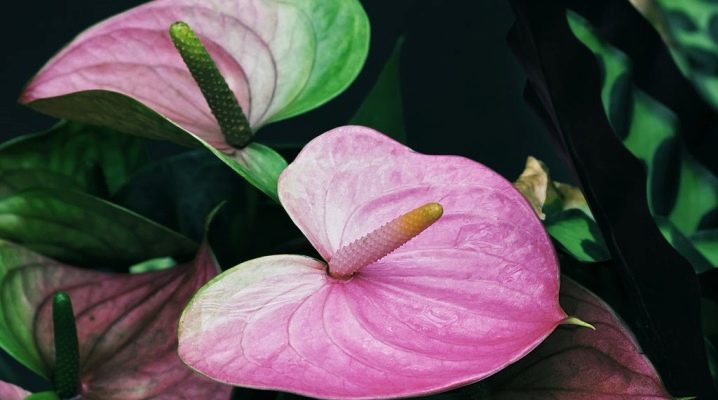
Anthurium is represented by several types, each with its own uniqueness. In order for a flower to please with abundant flowering, it is necessary to properly take care of it. Timely watering, prevention of diseases and insects, organization of lighting - all this allows any plant breeder to achieve success.
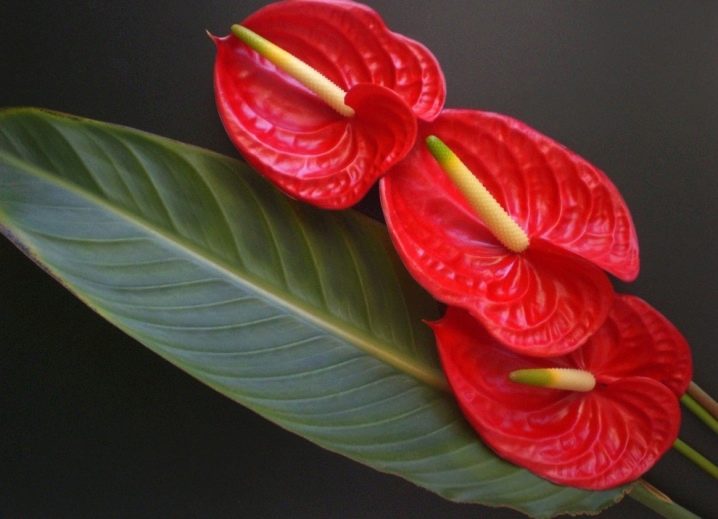
Peculiarities
Anthurium "Schercera" or "Schercerianum" is a popular houseplant that was brought from Costa Rica. It is a perennial flower with a small stem and dark colored leaves. Flowers form on long and smooth peduncles. During the flowering period, anthurium pleases with a yellow-orange shade of flowers, the length of which reaches a maximum of 8 centimeters. When the flowers fall, orange-red fruits appear in their place.
There are several varieties of this species, among them the equally beloved dwarf shrubs. Of all the anthuriums, it is this plant breeders who are considered the least demanding, but this does not mean that it is unpretentious and is able to withstand any conditions of detention.
Flowers appear only under the conditions of humidity, temperature and lighting. More than 8 buds do not appear in one period, so you should not expect abundant flowering.
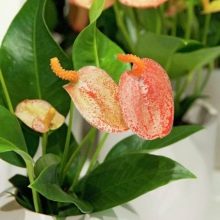
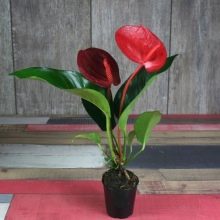
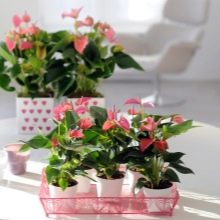
Varieties
The most common types, such as "Lindsay" or "Hannah", have a bedspread with a red or pink tint, no less popular varieties of the green palette, for example, "Amaretti" and "Smaragd". There are many varieties that are especially popular in flower shops because of their unique decorative characteristics. Among the varieties of "Scherzer" anthurium, it is worth highlighting several of the most common.
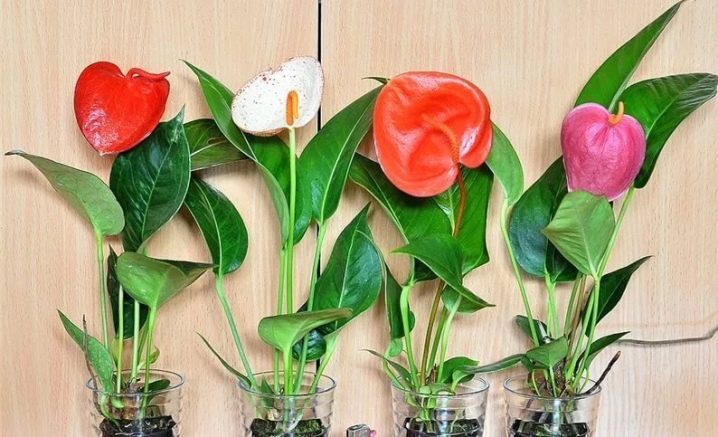
"Lacetti"
This type is widely used not only as a decorative design for a window sill, but also in floral arrangements of florists. The leaves have a pointed shape, their cobs are slightly curled. The height of the stems sometimes reaches 1.5 m. The flowers are pale pink.


"Graffiti"
The main distinguishing feature of this flower is a white, wide bedspread with irregularly scattered bright blotches.
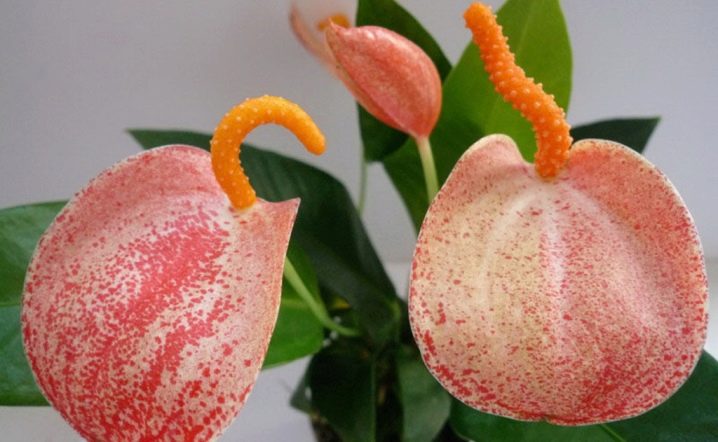
"Hawaii"
It is popular with breeders due to the presence of several shades on the flower. Sometimes it can be 3 at once - white, yellow and red, and in some cases only 2 - green and pink.
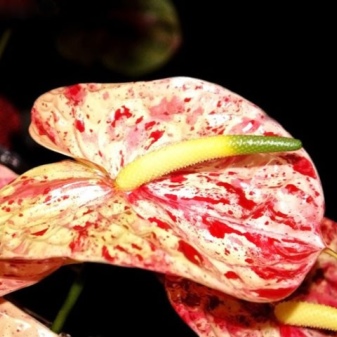

"Alexia Blue"
This variety is always in the collection of true connoisseurs, because its flower has an amazing blue color.
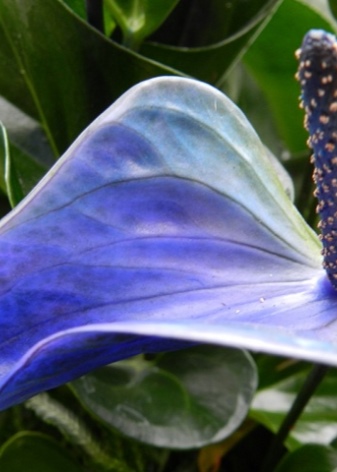
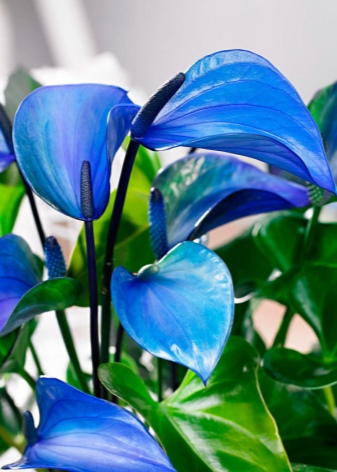
"Chocolate Love"
If we talk about the features of this flower, then first of all it is worth mentioning the contrast that the color palette possesses. The bedspread is colored dark chocolate, while the leaf plate is dark green.

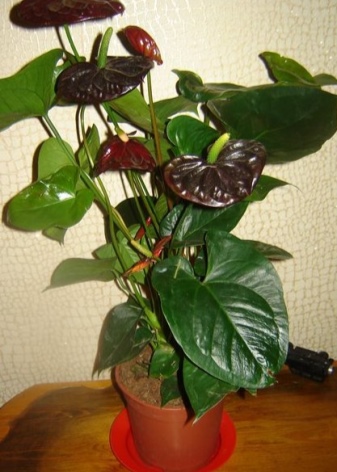
Rubens
It differs from other varieties in that it has an uneven color. From the edge to the base of the flower, the shade gradually changes from green to pink.
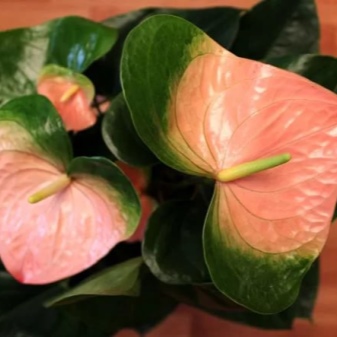
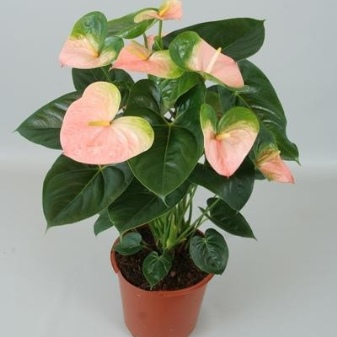
"Lindsay"
Flowers of this anthurium have a monochromatic shade. The maximum flower diameter is 10 centimeters. The leaves have pointed tips, the shape is elongated. On average, the plant reaches 40 centimeters in height.
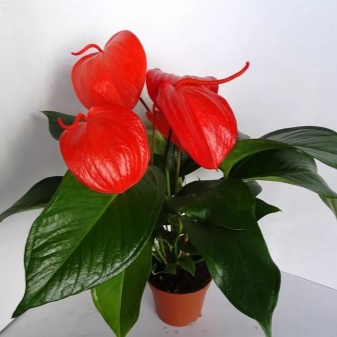
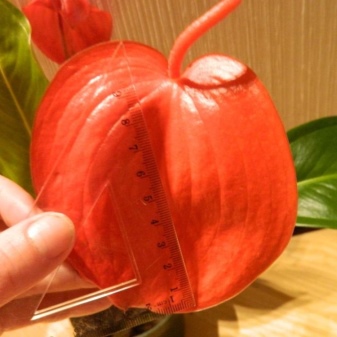
All the varieties described look best planted in one container. This mix is an amazing combination of colors and decorative forms.
Conditions of detention
The growth and flowering of anthuriums at home depends on many factors, including fertilization, light, and ambient temperature.
Due to their epiphytic nature, the indoor plants described require a well-aerated soil mixture, but the land must be irrigated and fertilized with high quality. Mixes successfully used in crop production include wood chips, fern chips, nut shells, including coconut flakes, and sugar cane. In our country, most of these ingredients are not easy to get, so experts offer simpler options:
- 1: 1: 1 - peat, perlite, bark;
- 1: 1 - peat: perlite;
- 2: 1 - peat and perlite.
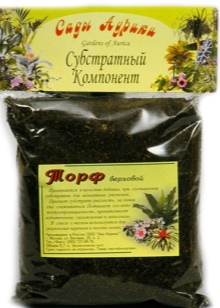
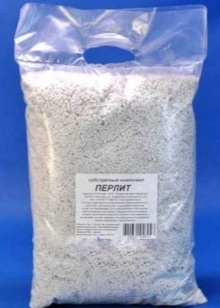
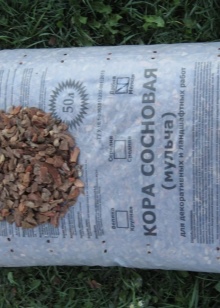
Install a flower pot in an area with partial shade or bright, indirect sunlight indoors, a few tens of centimeters from the window. It is important to avoid direct sunlight on foliage and flowers as it can cause burns. If there is a lack of light, additional artificial lighting can be arranged.
Anthuriums grow at a temperature of 60 to 85 degrees Fahrenheit and a humidity of 55 to 60%.
Experts recommend covering the roots and stems with a layer of moss or peat as the plant grows and the root mass increases. This layer protects them and maintains moisture in the ground.

How to care?
Anthurium care involves the timely application of fertilizers, the implementation of high-quality correct watering and much more.
The required level of soil nutrients, minerals and vitamins for anthurium depends on lighting. Can be used complex mixtures with a high content of fluorine, calcium. Each watering should be done with a 9-3-6 or 12-12-12 water-soluble top dressing mixed at 1/2 teaspoon per gallon of water. Use this solution, instead of irrigation liquid, once every 3 months.
It is imperative to spray the leaves of indoor anthuriums once a week to maintain the required moisture level around the plant. Ideal for this is a conventional spray bottle, settled, rain, filtered or distilled water.
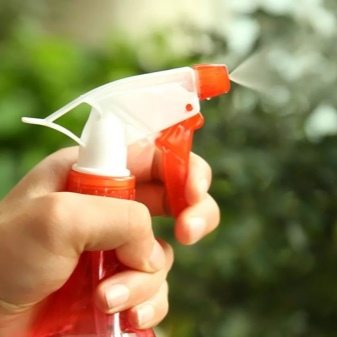
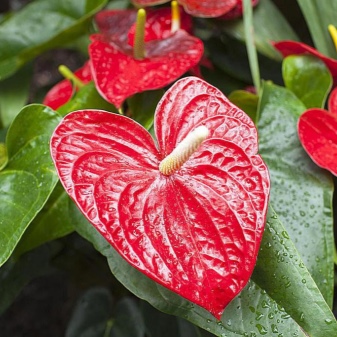
Watering indoor flower only during hot, dry periods, or when the soil dries out to a depth of several centimeters. The liquid must be added so that it flows through the bottom of the pot. Excess water is drained, the soil should not remain wet for a long time, since then putrefactive processes begin to arise.
As a preventive measure, it is advised to use sprays with insecticidal soap once a weekto prevent aphids, mites, thrips or mealy mites from growing.
Anthurium is transplanted as needed, when the roots fill the container. Use a pot with drainage holes. Each time, the diameter of the container should increase in size by 2-3 centimeters, but not more.
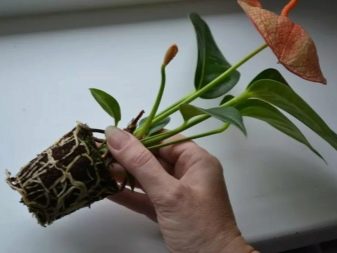

Diseases and pests are not always the main reason that the plant begins to hurt. Too much light results in white spots on the foliage, which can then brown and dry out. To remedy the situation, it is worth installing the pot on the window, where the sun's rays reach the foliage extremely diffused.
Sometimes the grower thinks that the more fertilizer he puts into the soil, the better for the flower. In practice, everything happens differently. If the lower leaves turn yellow and brown tips develop, it is a sign that it is time to stop feeding and an urgent need to leach the soil.
Too little light is also detrimental, for example, plants produce many leaves but few flowers.

Transfer
This is the same planting itself, only in a new container and soil. Most growers advise using mixtures with bark, as they are perfectly permeable to moisture and do not retain it for a long time. You can fill the container halfway with pebbles, then use a mixture of three parts orchid peat, one leaf, and the same amount of sphagnum moss. Coarse sand, charcoal or brick chips are added there.
Young anthuriums should be transplanted into a larger pot every 2-3 years. Immediately after transplanting, the soil is watered abundantly, and excess moisture is allowed to drain.
A good mixture for further cultivation can be a mix of peat moss, pine bark and perlite. All components are added at the same dosage.
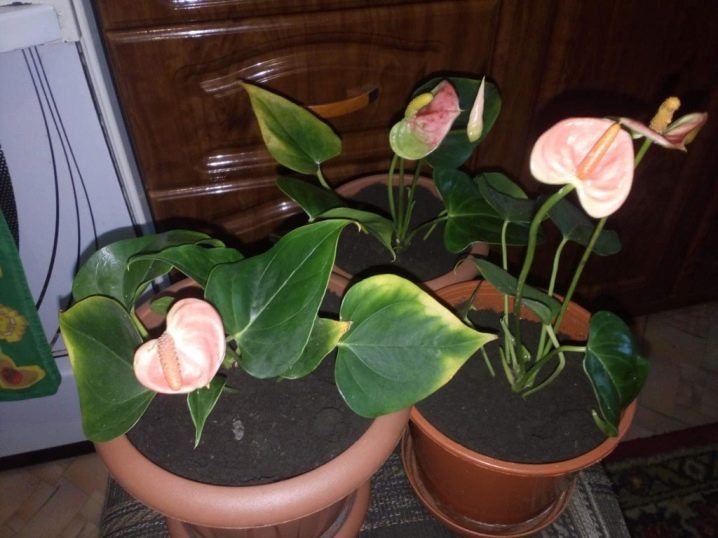
Let's consider the transplant process in more detail.
- First, the plant is carefully removed from the old pot. You can use a sharp knife to loosen soil around the edges.
- Place the mixture prepared in advance in a new pot with drainage holes, falling asleep not completely, but about 3 centimeters.
- They put a flower inside, but before that they clean the horse system of old soil and examine it. Old and diseased roots are removed, then the sections are treated with a solution of activated carbon.
- The flower, installed in a new container, is covered with soil, the soil is lightly tamped with the hand to remove air pockets.
- Top dressing at this stage is not done, only high-quality watering. Fertilizers can be applied after a few months, when the anthurium takes root.
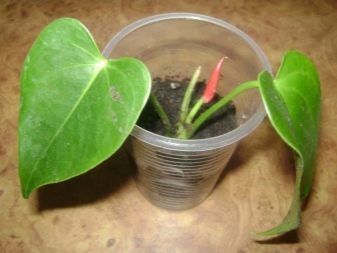
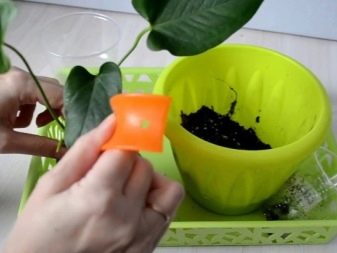
Reproduction
Anthurium can be propagated both asexually and sexually. Normal vegetative or asexual is accomplished through the use of terminal and single-node cuttings along with division from newly emerging branches.
The germination process is quite simple - you just need to place the planting material in favorable conditions for it. Sphagnum moss is an excellent remedy for this, you just need to moisten it well and put the container in a warm place with good ventilation.
To speed up the rooting process, you can create a greenhouse effect.
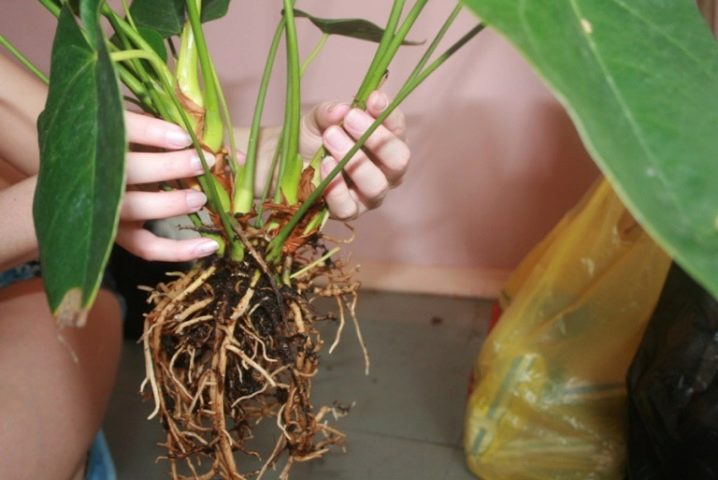
A flower is rarely propagated by seeds, because it is extremely difficult to achieve viable planting material at home. Moreover, the seeds require a high level of comfort to be maintained over a long period, the plant reaches adulthood only after a few years, and the growth process is slowed down.
Diseases and pests
Of the most common diseases in anthuriums - rot, which can be both root and root. With this infection, the tissues quickly deteriorate, darken and can cause an unpleasant odor. Infection is almost always associated with too high humidity. Therefore, in order to fight it, it is necessary to stop watering the flower for a while.
Late blight is the second most common disease, which is characterized by the appearance of first translucent, yellowish and water-moistened spots. Leaf spots can over time cover the entire flower or leaves in high temperature and moisture conditions. After some time, the formations turn black, usually surrounded by a bright yellow halo. If nothing is done, the flower will die. Prevention is always the best control against illness. The grower is advised to use not only fungicides, but also clean pots, disinfected tools.


Anthracnose - starts with tiny, brownish spots on the flower. At high humidity, they increase, turn into necrotic.
Often one has to deal with nematodes that successfully infect not only the roots, but also the foliage. This disease is characterized by growth retardation, the appearance of a small number of flowers.
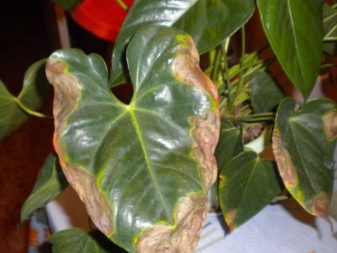
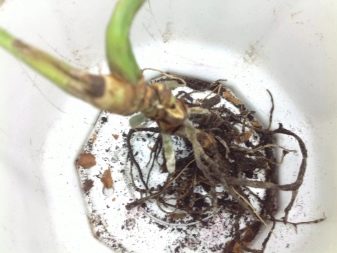
To protect yourself from the problem, you should initially purchase a healthy plant, use high-quality soil. Cuttings are advised to be immersed in hot water at a temperature of +50 degrees Celsius for 10 minutes before planting.
Of insects that like to feed on indoor plants, it does not lag behind in the frequency of aphid infestation. The good news is that it is very simple to deal with it - it is enough to even pour the plant under the shower, then let it drain well and dry. Neem oil, alcohol solution, and insecticidal soap work well.They are also suitable for controlling ticks, thrips and other pests.
How to grow Anthurium "Scherzer" from a leaf, see below.



























The comment was sent successfully.